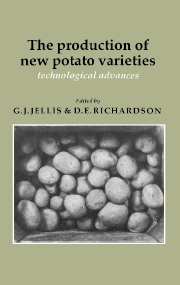Book contents
- Frontmatter
- Contents
- List of contributors
- Preface
- Editors' note and acknowledgements
- Introduction
- The development of potato varieties in Europe
- Genetic Resources
- Breeding Strategies
- Selection and Screening Methods
- The efficiency of early generation selection
- Problems associated with early generation selection of potato clones in West Siberia
- Influence of weight of seed tubers on selection of first year clones: preliminary results
- A joint cyst nematode/late blight test for early generation screening of potato clones
- Screening for resistance to diseases in a potato breeding programme
- Breeding for resistance to potato viruses with special reference to cDNA probes
- Screening for resistance to diseases and pests
- Breeding for resistance to and tolerance of potato cyst nematode
- Breeding multi-resistant potato germplasm
- Resistance to storage diseases in breeding stocks
- Phytophthora research at the Foundation for Agricultural Plant Breeding (SVP)/ The Netherlands
- Effect of time interval between inoculation and assessment on relative content of potato virus YN in leaves of potato plants
- Selection and evaluation of potatoes for improved tolerance of environmental stresses
- Variety Assessment
- Semi-conventional Breeding Methods
- True Potato Seed
- Unconventional Breeding Methods
- Commentary
- Index
Breeding for resistance to and tolerance of potato cyst nematode
Published online by Cambridge University Press: 05 March 2012
- Frontmatter
- Contents
- List of contributors
- Preface
- Editors' note and acknowledgements
- Introduction
- The development of potato varieties in Europe
- Genetic Resources
- Breeding Strategies
- Selection and Screening Methods
- The efficiency of early generation selection
- Problems associated with early generation selection of potato clones in West Siberia
- Influence of weight of seed tubers on selection of first year clones: preliminary results
- A joint cyst nematode/late blight test for early generation screening of potato clones
- Screening for resistance to diseases in a potato breeding programme
- Breeding for resistance to potato viruses with special reference to cDNA probes
- Screening for resistance to diseases and pests
- Breeding for resistance to and tolerance of potato cyst nematode
- Breeding multi-resistant potato germplasm
- Resistance to storage diseases in breeding stocks
- Phytophthora research at the Foundation for Agricultural Plant Breeding (SVP)/ The Netherlands
- Effect of time interval between inoculation and assessment on relative content of potato virus YN in leaves of potato plants
- Selection and evaluation of potatoes for improved tolerance of environmental stresses
- Variety Assessment
- Semi-conventional Breeding Methods
- True Potato Seed
- Unconventional Breeding Methods
- Commentary
- Index
Summary
Progress towards breeding potato varieties resistant to Globodera rostochiensis (Woll.) and G. pallida (Stone) has advanced considerably over the past decade. Recent developments at the Scottish Crop Research Institute (SCRI) in testing progeny with quantitatively inherited resistance, i.e. those derived from Solanum vernei (Bitt et Wittm.) and S. tuberosum ssp. andigena (Juz et Buk.) CPC 2802, have allowed genotypic parental values for resistance to G. pallida to be estimated (Phillips & Dale 1982). Data from such seedling progeny tests also allow the plant breeder to identify the most resistant progenies for further assessment and subsequent selection.
In parallel with improved progeny and parental selection for quantitative resistance to G. pallida has been the selective breeding and test crossing of parental material to produce parents which are triplex or quadruplex for the major gene H1, which confers resistance to G. rostochiensis (Ro1 and Ro4). The use of such parents guarantees that all members of derived progenies are resistant, eliminating the need for routine clonal testing for the H1 gene and thus releasing resources (Mackay, this volume).
After sowing the selected progenies, clones produced are tested for resistance to both G. rostochiensis and G. pallida in the third clonal year using closed containers (see also Lacey et al., this volume). Within these tests resistant, partially resistant and susceptible standard controls are used, allowing easy reliable comparisons both within and between tests and also between laboratory, glasshouse and field tests.
- Type
- Chapter
- Information
- The Production of New Potato VarietiesTechnological Advances, pp. 91 - 93Publisher: Cambridge University PressPrint publication year: 1987
- 1
- Cited by

